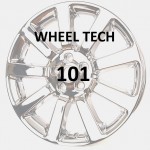
Wheels may look like glorified circles, but in actuality they are very complex devices that require high-tech, precision engineering processes to ensure that they do their job. Furthermore, millions of dollars are spent every year by original equipment manufacturers like
BMW,
Lexus,
Audi,
Jaguar,
Porsche,
Ferrari,
Infiniti and so on to make sure that every single wheel they put on a car, truck or SUV is durable, dependable, and even stylish.
So what makes up a wheel?
Here in
Wheel Tech 101, we'll go over the most basic elements of a wheel: its measurements.
Width and Diameter
These two are pretty obvious, so we won't spend much time on them. Suffice it to say, a wheel designated as 17 x 8 is a wheel that's 17 inches in diameter and 8 inches wide. Those particular measurements might be found on any BMW 3-series, a Jaguar S- or X-Type, Jeep Grand Cherokee SRT8 or Wrangler Rubicon, or a Lexus SC300 or IS250. And probably a bajillion other vehicles, too.
Offset
Wheel offset is simply the distance from the mounting surface of the wheel to the true centerline of the rim. It's something that's actually pretty hard to measure without some precision tools, but it's not impossible. Offset comes in positive and negative numbers:
- Positive offset is closer to the fender well, and means the mounting surface is positioned IN FRONT of the true centerline
- Negative offset means the wheeel will stick out away from the vehicle, because the mounting surface is BEHIND the centerline of the rim assembly
Bolt Pattern
Bolt patterns are usually written like this: 5x112. The first number (the "5") is the number of bolts that go on the wheel (typically 4, 5, or 6). The second number is the pitch circle diameter, which measures the diameter of the bolt circle...which, interestingly enough, means different things based on how many bolts the vehicle has.
For 4- and 6-bolt wheels, you're measuring from the center of one bolt hole to the center of the bolt hole directly across from it. A 5-bolt wheel requires a little geometry: mentally "draw" a circle running through the centers of each bolt hole, then measure from the center of a single bolt hole out to the imaginary circle that lays between the two opposite bolt holes.
Center Bore (a.k.a. "Hub Bore")
These two terms are synonymous, and measures the center hole in the wheel. This hole is used to center the wheel on the car's hub. Pretty simple, eh?
Mass production of wheels means that large center bores are common, so if you are trying to fit one type of BMW wheel on a different model of BMW, you might need to use something called a hubcentric hub ring to prevent or eliminate any vibration or noise caused by there not being a perfect fit.
***
For more info:
Did this article help you? Did we miss anything, or mess something up? Let us know in the comments below, or by contacting us! Wheels may look like glorified circles, but in actuality they are very complex devices that require high-tech, precision engineering processes to ensure that they do their job. Furthermore, millions of dollars are spent every year by original equipment manufacturers like BMW, Lexus, Audi, Jaguar, Porsche, Ferrari, Infiniti and so on to make sure that every single wheel they put on a car, truck or SUV is durable, dependable, and even stylish.
So what makes up a wheel?
Here in Wheel Tech 101, we'll go over the most basic elements of a wheel: its measurements.
Wheels may look like glorified circles, but in actuality they are very complex devices that require high-tech, precision engineering processes to ensure that they do their job. Furthermore, millions of dollars are spent every year by original equipment manufacturers like BMW, Lexus, Audi, Jaguar, Porsche, Ferrari, Infiniti and so on to make sure that every single wheel they put on a car, truck or SUV is durable, dependable, and even stylish.
So what makes up a wheel?
Here in Wheel Tech 101, we'll go over the most basic elements of a wheel: its measurements.

